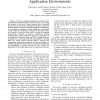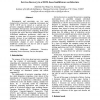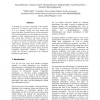INTERSENSE
2006
ACM
14 years 5 months ago
2006
ACM
— Mobile Ad-hoc Networks (MANETs) are seen as an essential technology to support future Pervasive Computing Scenarios and 4G networks. In a MANET, efficient support of multipoint...
INTERSENSE
2006
ACM
14 years 5 months ago
2006
ACM
— Pervasive computing applications typically involve rich interactions and heterogeneous network types; e.g. involving the collation of data from a sensor network into a replicat...
AINA
2006
IEEE
14 years 5 months ago
2006
IEEE
Pervasive computing is becoming a reality, thanks to advances in wireless networking and increased popularity of portable devices. Users of these devices will need support to deci...
SEKE
2007
Springer
14 years 5 months ago
2007
Springer
We define adaptability as the capacity of software in adjusting its behavior in response to changing conditions. To list just a few examples, adaptability is important in pervasiv...
EEMMAS
2007
Springer
14 years 5 months ago
2007
Springer
Multiagent systems for mobile and pervasive computing should extensively exploit contextual information both to adapt to user needs and to enable autonomic behavior. This raises th...
CSCWD
2007
Springer
14 years 5 months ago
2007
Springer
Heterogeneity and uncertainty are two main characteristics of pervasive computing environment and CSCW. CSCW can be viewed as a special case of pervasive computing. Middleware is ...
BIOWIRE
2007
Springer
14 years 5 months ago
2007
Springer
Emerging pervasive computing technologies such as sensor networks and RFID tags can be embedded in our everyday environment to digitally store and elaborate a variety of informatio...
ICC
2007
IEEE
14 years 5 months ago
2007
IEEE
—This paper addresses context issues in pervasive mobile computing and presents a semantic context model to support location based cooperative mobile applications. In this paper,...
SASO
2008
IEEE
14 years 5 months ago
2008
IEEE
Self-management is one of the challenges for realizing Ambient Intelligence in pervasive computing. In this paper, we propose and present a semantic web based selfmanagement appro...
ICECCS
2008
IEEE
14 years 5 months ago
2008
IEEE
A challenge for pervasive computing is the seamless integration of computer support with users’ activities in a very dynamic setting, with deep human and resource mobility. Port...



